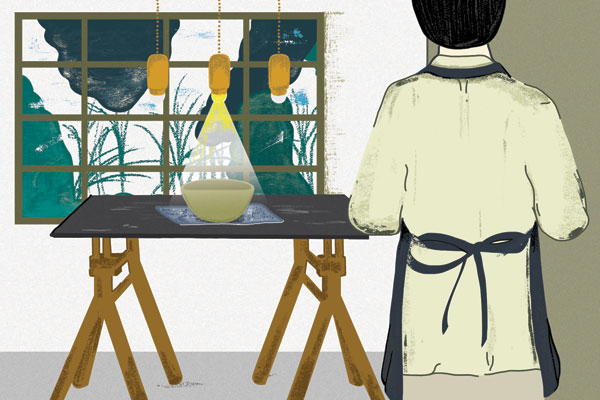Every object has a story, and every choice we make as consumers has an impact. Lee Meiling, co-founder of SUPERMAMA, writes.

May 19th, 2015
Illustration: Zann Lim
What comes to mind when you see a beautiful piece of design? I used to look at such objects, appreciate them for what they were, and if I liked them enough, I would buy them and bring them home. That used to be my point of view as a consumer. But my appreciation of design and good craftsmanship deepened after my experience of visiting and working with several craft facilities in Japan, and it has since redefined the way I look at the value of design.
Good design is important as it enhances the value of a product, and it is a key criterion as my husband and I source and produce items for our retail gallery SUPERMAMA. Therefore, since we started our business some three years ago, we have always been on the lookout for well-designed objects. More importantly, we have begun collecting the stories of the objects, hoping to share the love for design with our customers. Slowly but surely, we sensitised ourselves to the process of listening in to many stories from designers and craftspeople from all walks of life. Some of them were holding on to full-time jobs while persisting in their love for design.
It came to a point where almost every product in our gallery had a story, and we as shopkeepers were more than happy to share them with anyone who walked through our door. It was not the most practical way to run a business. Nevertheless, it was our little way to contribute to design education. We believe that design is for everyone and we endeavour to introduce design appreciation to more people.
After our first year of retail operations, we had the opportunity to visit the craftspeople and designers in their facilities and studios. I will always remember our first encounter with a particular Japanese craftsman. We were elated to see his creations – wooden pebbles. “Wooden pebbles with organic shapes! What beauties!” we thought. In our excitement, we turned to the craftsman and asked if we could bring them back to Singapore for retail. He was overwhelmed by our request and shed a tear right there and then. Our actions actually created a possibility that his works could reach an overseas market, and this touched him greatly. It was not the quantity of the order, but just the opportunity that was more than enough for him. Yes, we did bring Kokoro, the name of the wooden pebbles, back to our gallery and many more people were touched by the story.
Just recently, my husband went to another prefecture in Japan and participated in an organised session in which he was sharing the story of how we collaborated with the porcelain facility, Kihara. It was the story of how we created our first collection of the Singapore Icons. There was a craftsman who asked many questions vehemently. Immediately, my husband assumed that the craftsman was sceptical and wanted to ruin the session. Afterwards, the two were properly introduced and the craftsman went on to explain how there used to be ten kilns in the prefecture, but now there are only three. One of them belongs to him. He was the craftsman who produced a series of green ceramic bowls that was retailing in our store back in Singapore. We then realised that his vehement questioning was his quest for survival – a result of his hope that his works would break through into international markets and extend the possibility of livelihood from a dying trade.
Such experiences remind us not to treat design and craft lightly, because each object has a story of its own – a story of its design, its form, and more than that, a story of responsibility which is sometimes greater than what we could imagine. This is how we realised that our efforts are not just about design; they are also about designing responsibility – an exploration of how design can bring lost and dying trades to life. And through that, how design could sustain livelihoods. We think this is what keeps us going.
This article first appeared in Cubes Indesign issue 72
SUPERMAMA
supermama.sg
A searchable and comprehensive guide for specifying leading products and their suppliers
Keep up to date with the latest and greatest from our industry BFF's!

Sub-Zero and Wolf’s prestigious Kitchen Design Contest (KDC) has celebrated the very best in kitchen innovation and aesthetics for three decades now. Recognising premier kitchen design professionals from around the globe, the KDC facilitates innovation, style and functionality that pushes boundaries.

Savage Design’s approach to understanding the relationship between design concepts and user experience, particularly with metalwork, transcends traditional boundaries, blending timeless craftsmanship with digital innovation to create enduring elegance in objects, furnishings, and door furniture.

The Sub-Zero Wolf showrooms in Sydney and Melbourne provide a creative experience unlike any other. Now showcasing all-new product ranges, the showrooms present a unique perspective on the future of kitchens, homes and lifestyles.

In the pursuit of an uplifting synergy between the inner world and the surrounding environment, internationally acclaimed Interior Architect and Designer Lorena Gaxiola transform the vibration of the auspicious number ‘8’ into mesmerising artistry alongside the Feltex design team, brought to you by GH Commercial.
The internet never sleeps! Here's the stuff you might have missed

2024’s theme, “Reawaken,” calls for a journey through reinvention and sustainability.

Landing in the city’s financial district for the first time, The Sebel Sydney Martin Place has had its modern interiors completed by Stack Studio.